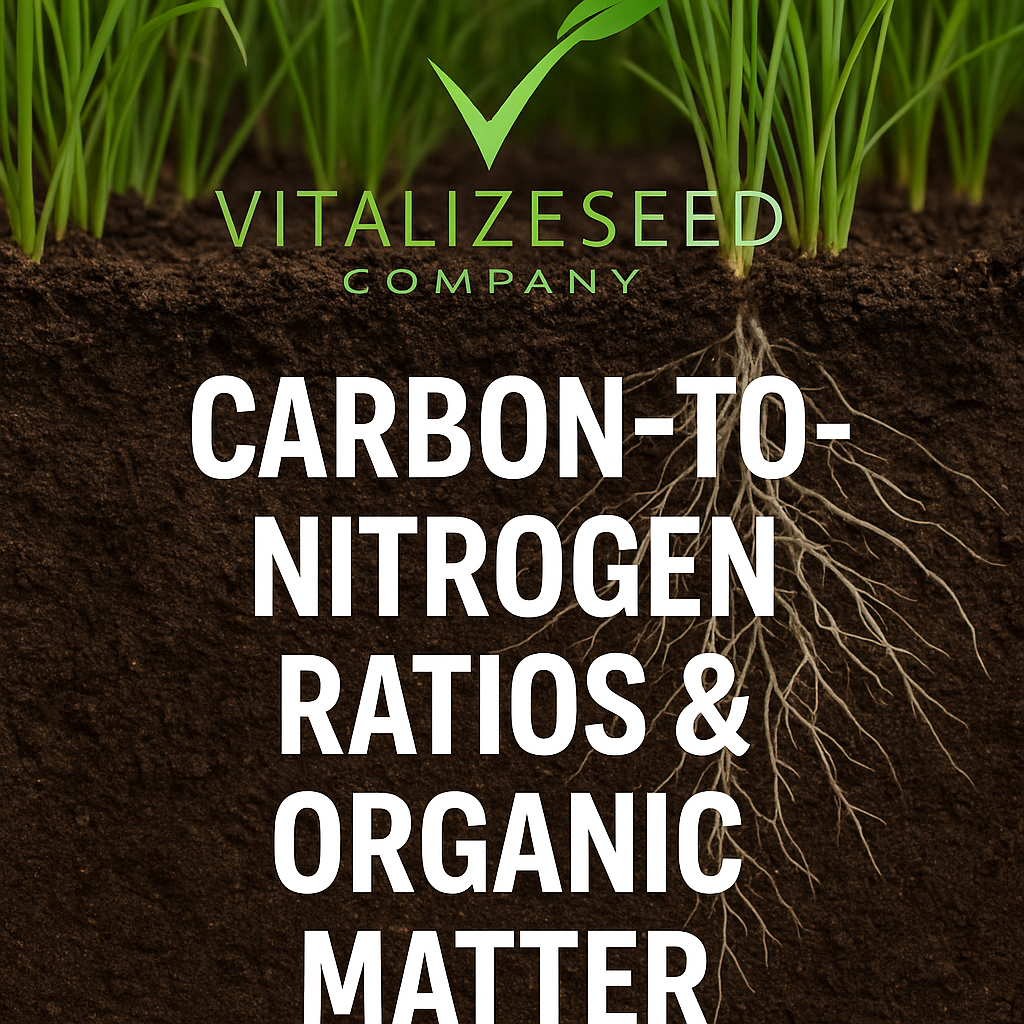
Balancing Carbon and Nitrogen: The Key to Healthy Soil, Thatch Control, and Long-Term Fertility
Share
Carbon-to-Nitrogen (C:N) ratios are often misunderstood—and even more often, they spark debate. Yet this balance plays a foundational role in soil health, nutrient cycling, and long-term productivity. In this blog, I’ll break down the science behind C:N ratios and soil organic matter, highlight common misconceptions, and share practical insights on managing them in real-world field conditions.
Understanding how carbon-to-nitrogen (C:N) ratios influence soil health, nitrogen availability, and organic matter cycling is key to managing resilient food plots, cover crops, and perennial systems. Nitrogen, while essential, plays a dual role—supporting decomposition in high-carbon environments but potentially degrading soil structure and microbial life when misapplied[^1,^11].
Understanding Carbon-to-Nitrogen (C:N) Ratios
The C:N ratio is the mass of carbon relative to nitrogen in organic material. It determines decomposition speed, microbial activity, and how nutrients are cycled through the soil.
- Soil organic matter (SOM) stabilizes around a 10:1 C:N ratio, while the ideal microbial diet is closer to 24:1[^2].
- Common plant residues:
- Cereal rye at seed set: ~80:1
- Corn stover: ~57:1
- Hairy vetch: ~11:1
Why it matters:
- High C:N residues (>30:1), like mature rye or straw, tie up nitrogen. Microbes require N to break down carbon. If it’s unavailable, microbial activity slows, and populations decline, reducing microbial biomass and diversity and causing nutrient tie-up[3, 11]. This often drives more synthetic nitrogen applications or tillage interventions.
- Low C:N residues (<25:1), like legumes, release nitrogen and accelerate microbial metabolism. However, if the C:N ratio is too low, microbial growth can spike rapidly. When easily accessible carbon is depleted, microbes may begin mining stable soil organic matter (SOM) as a carbon source—even in no-till systems—depleting long-term fertility[^4,^11].
Active vs. Stable Soil Organic Matter
Soil organic matter (SOM) can be divided into two major pools with very different behaviors:
1. Active Organic Matter
- Composed of fresh plant residues, root exudates, and microbial biomass.
- Rapidly mineralized through microbial digestion and weathering.
- Drives:
- Seasonal nitrogen cycling
- Microbial activity
- Short-term nutrient release
- Plant productivity and yield in-season[^5]
2. Stable Organic Matter (Humified Fraction)
- Forms through humification, where microbes transform residues into complex, persistent compounds.
- C:N ratio stabilizes around 10:1.
- Chemically recalcitrant and resistant to decomposition, containing:
- Phenolic compounds
- Lignin derivatives
- Long-chain aromatic and aliphatic carbon chains[^6]
- Benefits:
- Long-term carbon sequestration
- Soil structure improvement
- Increased water-holding capacity
- Enhanced cation exchange capacity (CEC)
Key examples:
A green cover crop like hairy vetch (~11:1) decomposes rapidly, releasing nutrients but contributing little to stable SOM—much of its carbon is lost as CO₂ through microbial respiration[^7]. Building humified SOM takes time, biodiversity, and management practices that favor carbon stabilization over rapid mineralization. Balanced C:N residue blends, like those in the Vitalize One-Two System, are ideal for this.
The Dual Nature of Synthetic Nitrogen in High-Carbon Systems
In perennial monocultures (e.g., ryegrass, turf), plant biomass builds with a high C:N and decomposes slowly. Over time, this results in thatch accumulation—a dense, fibrous mat of undecomposed roots and shoots.
When Nitrogen Helps:
- Supplemental nitrogen can activate microbial communities in high-carbon systems, helping to decompose thatch and restore nutrient availability[8].
- This temporary boost is beneficial when residue breakdown is nitrogen-limited.
When Nitrogen Hurts:
Applying excess synthetic nitrogen—especially without corresponding carbon inputs or residue diversity—can create several problems:
- Microbes shift from decomposing surface residue to “mining” stable SOM for carbon[^9,^11].
- Accelerated SOM loss exceeds natural mineralization rates, degrading long-term soil function.
- Reduced microbial diversity due to overfeeding of opportunistic organisms.
- Declines in root exudate production occur as plants rely more on inputs than symbiotic relationships.
- Biomass production may outpace microbial processing, worsening thatch accumulation and nutrient tie-up[^10].
The Vitalize Seed Approach: Working With Biology, Not Against It
Vitalize Seed’s “One-Two Punch” system addresses these challenges by promoting biologically balanced nutrient cycling:
- Spring/Summer: Nitro Boost
- Low C:N, legume-rich mixes stimulate microbial activity and build plant-available nitrogen.
- Fall: Carbon Load
- High-carbon biomass builds surface residue and thatch for protection, while feeding the soil long-term.
Together, these seasonal blends deliver a diverse microbial diet, supporting both active cycling and stable SOM formation via humification. The result is healthier soil, less input reliance, and resilient productivity.
Takeaways
- Monitor C:N ratios in cover crops and residue: balance high-C crops (e.g., rye) with legumes (e.g., clover, vetch).
- Avoid synthetic nitrogen in monocultures unless decomposition is clearly stalled.
- Pair N with carbon to prevent SOM depletion—microbes need both to thrive.
- Support both active and stable OM through diverse, seasonally optimized cover cropping.
- Thatch is not the enemy—it's a signpost. It becomes problematic only when nutrient imbalances and microbial constraints go unaddressed.
Conclusion
Nitrogen can either build soil or break it down, depending on its balance with carbon. In high-C environments, it helps decompose residue; in excess, it triggers microbial mining of stable SOM and loss of long-term fertility.
By understanding the difference between active and stable organic matter—and how microbes use them—we can make more informed decisions about nitrogen use. Systems like Vitalize Seed’s One-Two Punch keep carbon and nitrogen in harmony, reducing inputs while improving both productivity and ecological resilience.
For growers seeking a deeper, highly readable guide to soil function, Jon Stika’s A Soil Owner’s Manual is a foundational resource that supports many of the principles outlined here.
References
- Drinkwater, L.E., et al. (1998). Legume-based cropping systems have reduced carbon and nitrogen losses. Nature, 396(6708), 262–265.
- Paul, E.A. (2014). Soil Microbiology, Ecology and Biochemistry (4th ed.). Academic Press.
- Magdoff, F., & Weil, R. (2004). Soil Organic Matter in Sustainable Agriculture. CRC Press.
- Cotrufo, M.F., et al. (2013). The Microbial Efficiency-Matrix Stabilization (MEMS) framework. Global Change Biology, 19(4), 988–995.
- USDA NRCS. (2011). Soil Health – Unlocking the Secrets of the Soil.
- Lehmann, J., & Kleber, M. (2015). The contentious nature of soil organic matter. Nature, 528, 60–68.
- Sainju, U.M., et al. (2006). Cover crop effects on soil carbon and nitrogen dynamics. Soil Science, 171(10), 821–829.
- Zuberer, D.A. (2005). Nitrogen in Soils. Texas A&M University Soil Microbiology Series.
- Janzen, H.H. (2006). The soil carbon dilemma: Shall we hoard it or use it? Soil Biology & Biochemistry, 38(3), 419–424.
- Carreira, J.A., et al. (1997). Nitrogen mineralization in perennial grassland and turf systems. Soil Biology & Biochemistry, 29(5–6), 897–903.
- Stika, Jon. (2016). A Soil Owner’s Manual: How to Restore and Maintain Soil Health. Acres U.S.A.
